January 2010 Newsletter
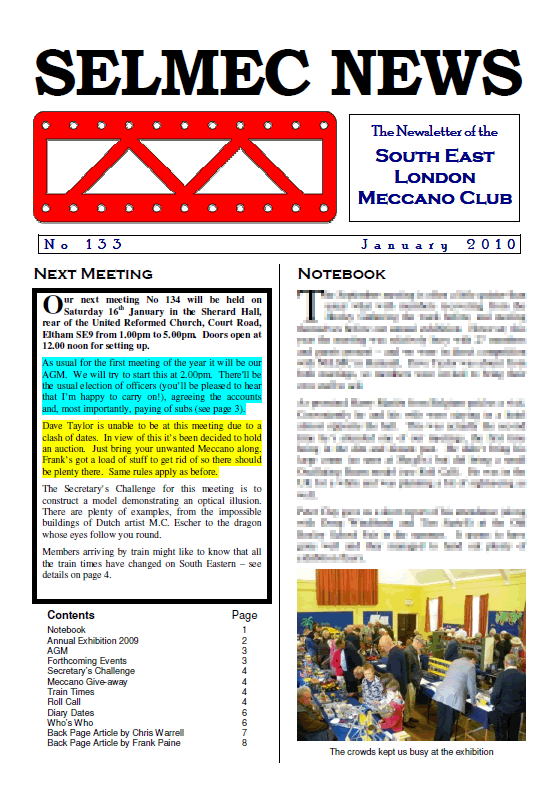
January 2010 Newsletter
Issue 133
This was one of our informal quarterly meetings where our members showed off their latest Meccano creations.
At around 2:00pm we had a short committee meeting, followed by the Model Tour in which members were invited to give a short talk about their models — in particular their entries for the Secretary’s Challenge!
Report written by Chris Warrell
It was 30 years since our very first exhibition and I was hoping for a good turnout of models. We had done so well the previous year that I didn’t want the members to let the club down. I needn’t have worried! Once again the hall was packed with models!
Watch our video of the exhibition
When Cathy and I arrived just before 8:00am some members were already in the hall re-arranging the tables laid out by the caretaker, John Swinburne. There was a slight problem in that the Russian language class was meeting in the smaller room and they required a few tables. There is a shortage of tables anyway and we normally have to press into action all sorts of odd shaped tables for the exhibition. Luckily we were able to get around the problem, but we were short of one of the square tables for the whole day. We were fortunate that Frank Paine brought his usual three heavy table tops and a couple of pasting tables and Keith Patey brought his two heavy duty folding tables. Without these additions we would have models displayed on the floor!
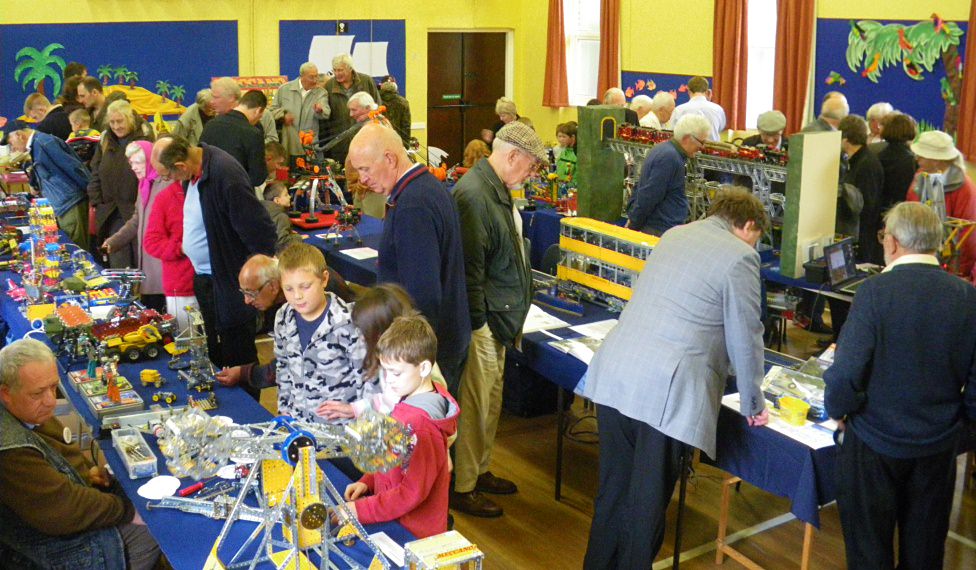
The crowd kept us very busy
The first sight for the visitors after entering the building was Tim Surtell’s marvellous triangular exhibition logo in Meccano hanging on the wall, with Adrian Ashford’s windmill (with coloured lights) on a table beneath.
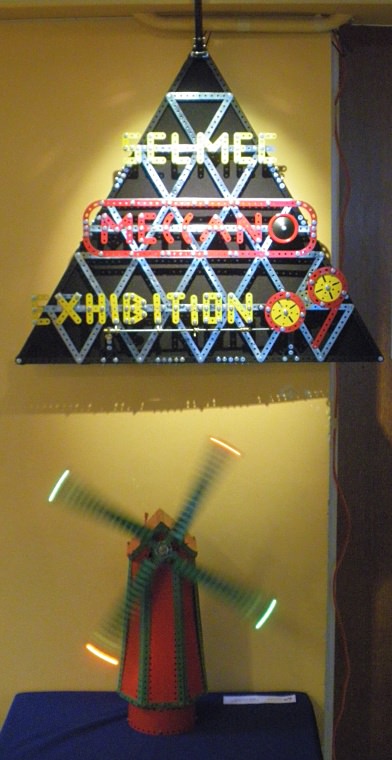
Tim’s sign with Adrian’s windmill
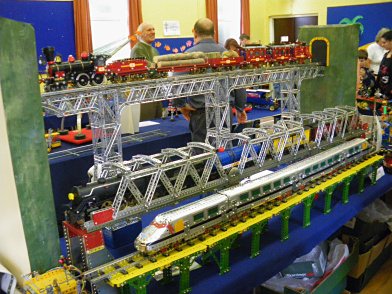
Ivor Ellard’s railway viaducts
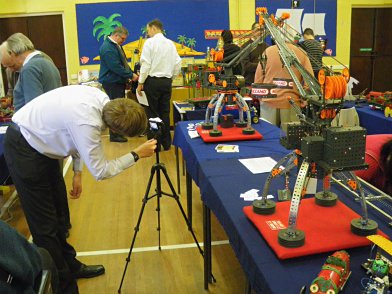
Tim Surtell lines up a shot of Ralf Laughton’s cranes
We had our biggest numbers since 1991 — very nearly 300 people attended. That includes all the accompanied children for whom we gave out tickets. This was up by 75 on last year and more than twice that of 2007. This may well be explained by our greater presence in the summer at the Great Get Togethers and the Old Bexley Church of England Primary School Summer Fete as well as leaving leaflets at these events and a number of local model railway exhibitions. We also had a decent plug in the News Shopper and Mercury free newspapers. I didn’t see any reporting of the exhibition despite the former sending a photographer along on the day.
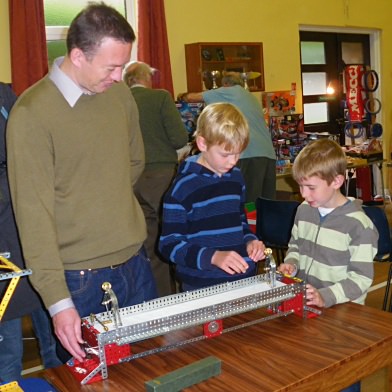
A family have fun playing Keith Patey’s hockey game
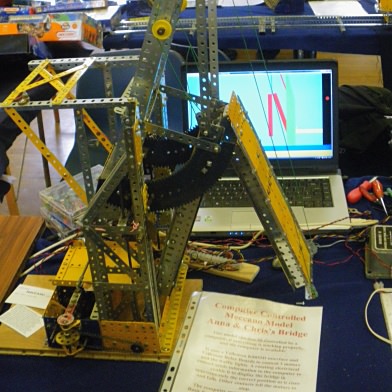
Dick Watson’s bridge
As is now usual we held a raffle and there were a good selection of quality prizes, mostly donated by members, so thanks are due to all of them. Thanks are also due to all those of you who helped with the setting up and clearing away of the hall, tying up posters etc. and filling the various slots of the rotas.
Models on Display
Jim Arthur — Ferris wheel; 108mm howitzer; Selection of small engines.
Adrian Ashford — Routemaster bus with front entrance; Empress of Britain liner; 1954 № 6 outfit windmill with lights (sited in the entrance to the hall); Tractor and trailer; Chariot and driver; Archimedes ball roller; Improved refuse wagon from 1954 № 7 set; Re-modelled low loader from the same set with a № 5 set excavator.
Geoff Carter — 30-model set tractor, as sold by M&S as a 1-model set; Motorcycle with twin front wheels, from the current Design 1 set; Racing motorcycle, from the 1990s Dynamic set; Biplane, from the 1-model M&S set; Downhill Racer, based on a design by Roger Le Rolland, using spanners for the chassis (between the biplane and the tanker); 3 models from the Bernard Périer’s Zkwyx Meccanaut book: Archie, the caterpillar soldier, the Robot Butler and Jog-Dog; Three other models designed by Bernard Périer: 1:80 scale articulated tank lorry, Bugatti and Boeing ‘Sea Knight’ helicopter; 1918 Bates ‘Steel Mule’ tractor, a model designed by Bruce Geange; Sopwith Camel, from a M&S set; Rolls-Royce ‘Silver Ghost’, a model designed by John Herdman.
Peter Clay — ‘Ultrasupervariograph’ Meccanograph, now motorised (the model was kept running producing ‘take-away’ designs); Hand operated foundry crane, rebuilt in the January 1967 issue of Meccano Magazine; Goliath Pionier 3-wheeled German car; Motorbike from Calais ‘one model’ set; Woodpecker, that pecked its way down a tree trunk (axle rod!); Small tractor from M&S set; Travelling chess and draughts set; Simplicity sports car; Dad’s Army butcher’s wagon; Chinese south-facing chariot with unusual mechanism running on half-inch pulleys and tyres; 3 larger ‘robot in a tin’ set models.
John Cowdery — The owl and pussycat in a pea green boat; Dancing figure; The band; Foden 8-wheel lorry with 4-wheel steering; Electrical mechanical horse; Various small models.
Ivor Ellard — Railway viaducts and bridges with a selection of trains.
Brian Elvidge — Skyrider fairground ride, modified using a different electric motor, wider cars and large axle system; Road compactor from the July 1969 issue of Meccano Magazine, modified with a modern electric motor and changes to the steering system; 1962 Set № 3 1950s MG car; Metal robots collection.
George Foard — Ball rolling machine; Unicyclist and double unicyclist.
Simon Greatrex — Mamod workshop powered by a horizontal steam engine.
Stuart Jones — Absent from the exhibition but his Mechanoids models were there.
Ralph Laughton — French crane display models.
Brian Leach — Fruit machine.
Frank Paine — A dealers display model of a Ferris wheel with coloured lights; Super Model Leaflet 1 motor chassis; Small beam engine; ‘Schools’ class locomotive and tender based on the post-war № 10 set Special Model Leaflet; Dealers display model of Tower Bridge with coloured lights and raising bascules; Dealers display model of Stephenson’s ‘Rocket’; A simple horizontal steam mill engine; Super Model Leaflet traction engine and a twin cylinder Mamod steam engine as a base for a Meccano crane; A selection of six different vintage Meccano outfits dating from 1913 up to the 1960s, together with Meccano literature and display material.
Keith Patey — Hockey game from the December 1950 issue of Meccano Magazine.
Ivor Perrett (visitor from Runnymede Meccano Guild) — Sir Malcolm Campbell’s Bluebird racing car from a 1950 № 6 manual.
Eric Smith — Two trams running on twin 3’ long tracks. They have 3–6V motors and trolley arms for overhead current collection.
Tim Surtell — 2009 exhibition sign which was also used on the SELMEC website and in the promotional video.
David Tracy (visitor from Runnymede Meccano Guild) — London taxi from the № 7 manual from 1956; Streamlined sports car from the 1956 № 8 set, similar to early Jaguars; Racing car typical of the type to be seen at Brooklands.
Chris Warrell — HR1 London tramcar on 10’ of track; Mathematical Bridge; Various cars, robots and other small models.
Dick Watson (visitor from North West Meccano Guild) — Anna and Chris’s folding bridge, computer controlled; Bernard Périer’s ‘John the Navvy’.
Alan Wenbourne — Mini London Eye.
Douglas Windibank — Radar scanner; Braced girder lorry; Spanner garden seat; Tank; Troop carrier; Field gun and limber; Steam lorry; Sea bed walker; Motorised digger; One-man hover craft; Red Arrow; Two small space models; Ferris wheel; German Eitech set; Plastic Meccano puzzle.
Written by Chris Warrell
Following on from his Top Toys programme four years ago, James May has now given us a whole series devoted to Hornby Trains, Scalextric, Lego, Plasticine, Airfix and, of course, Meccano.
Most, if not all, of you will have watched the programme on Meccano where a team of university students constructed a Meccano bridge to span an extension of the Leeds and Liverpool Canal in Liverpool. The pair of graduates who came up with the concept called it the bridge of no return because, as you will have seen when James walked across it, the bridge was in two halves, the first half being almost boomerang shaped such that it rolled forward with his weight. A counterbalance was gradually drained of water to allow this to happen, but as soon as he stepped off, the bridge rolled back, leaving him on a shorter swing section which carried him the rest of the way.
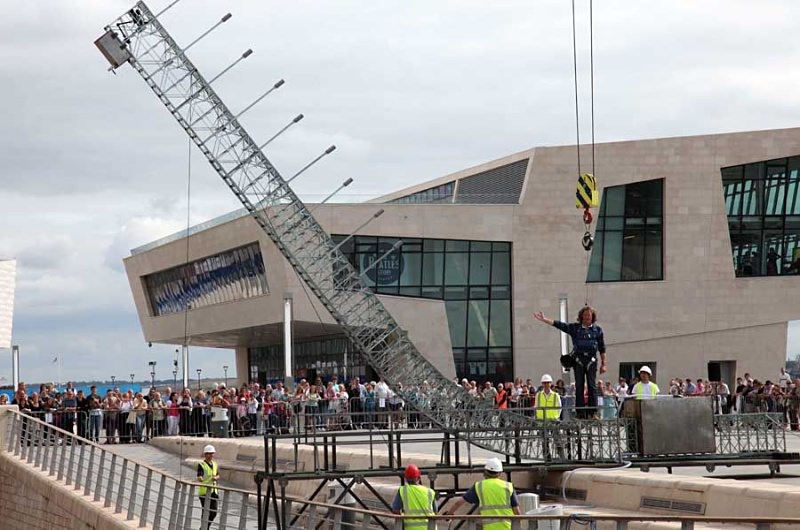
James May walks across the Meccano bridge
The programme was highly entertaining and, for the general public not familiar with Meccano, gave a short history of the system, and a look at Jim Gamble’s collection which is in his loft.
It proved that Meccano is real engineering in miniature, because the bridge, although only 14 inches wide and two feet deep, was able to span the 36 plus feet of the canal and support James May without any trouble at all. I can see why he had the safety harness, though — it looked somewhat precarious!
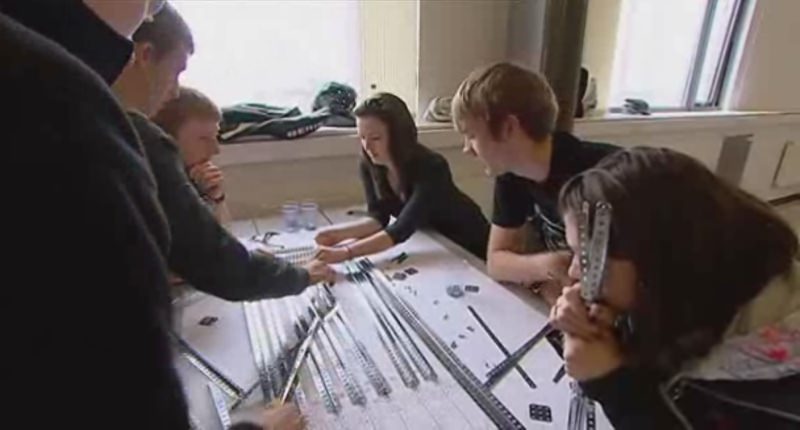
Students from the University of Liverpool build the bridge
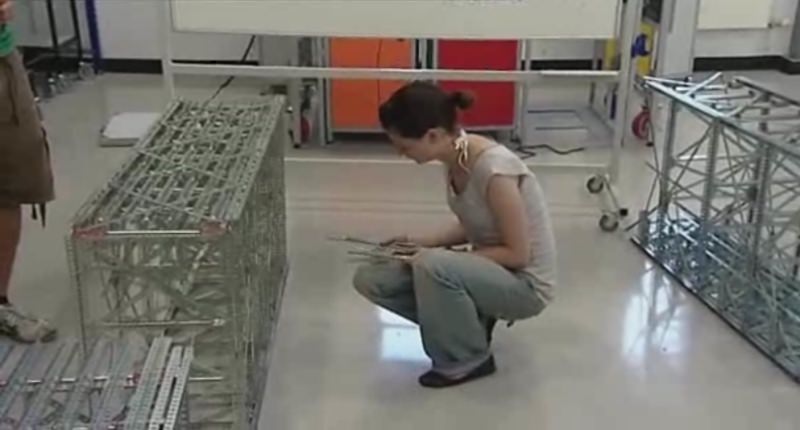
A student from the University of Liverpool building the bridge
Other programmes in the series have been equally fun to watch. They’ve been very popular as well, with the first two shows taking the top slot for BBC2, the next two being beaten only by Top Gear. The Meccano programme gained a respectable 3.86 million viewers. Most popular at the time of writing (ratings for the two Christmas episodes have not been published yet) was the Scalextric recreation of the Brooklands race track. There are rumours of a second series — perhaps they might have another go at the Meccano car that they were suggesting at the start of the project before they settled on the bridge idea.
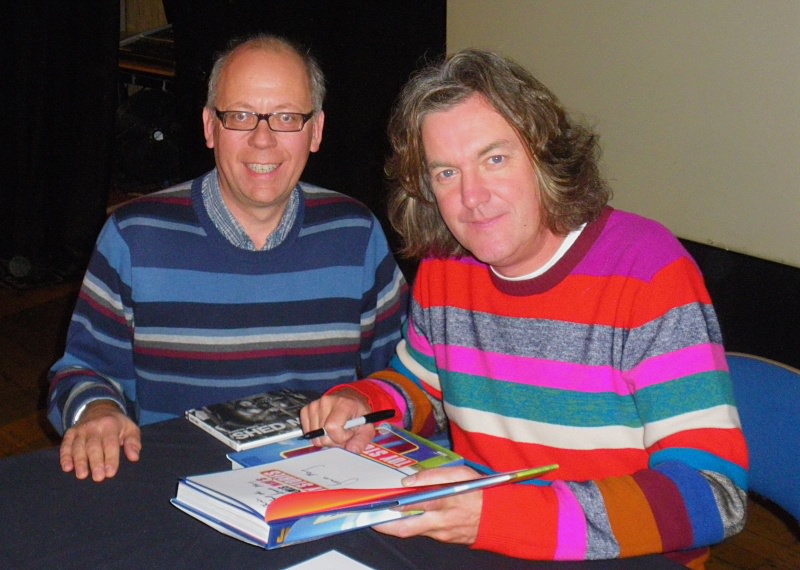
The great man himself — and some bloke called James May!
Tied in with the series was a one day toy show at the Camden Centre, opposite St. Pancras Station on Saturday 28th November. The entry price of £20 might seem a bit steep, but for that you got a free signed copy of the book of the series (priced at £20, although available at Amazon for £10). Children were admitted free — not much use to me; I don’t have any of the right age.
I turned up at around 2:30pm (having had a commitment earlier that day) to find the main hall in the Centre full of people, with lots of children rushing around from one activity to the next. On the stage James May was half way through the book signing, the queue of which snaked its way around the hall. I joined it later on when it had got a bit shorter having persuaded the staff at the rear of the queue to let me in — a number of other visitors did the same and the staff gave up trying to keep the queue from growing.
I was pleased to see that the Meccano Liver Bird was proudly standing on a table on the left side of the stage — one of only a few artefacts from the TV series to make it to Camden. At the back of the stage was a screen showing episodes from the series on a continuous loop.
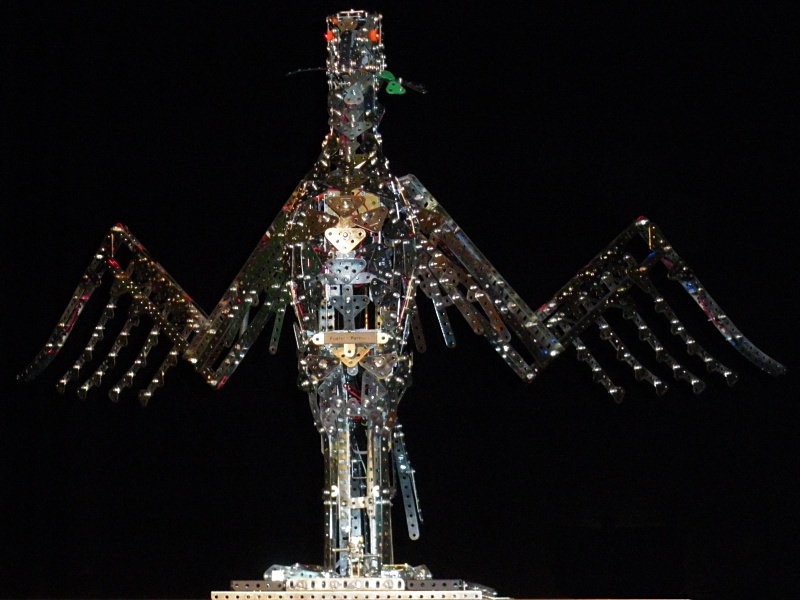
The Meccano Liver Bird
Around the hall was a different area for each of the six toys featured in the programmes: you could enter a Meccano model building competition; admire a Hornby model railway layout; make your own Airfix model; build a Lego model; create your own Plasticine flowers; race against other visitors on a Scalextric circuit.
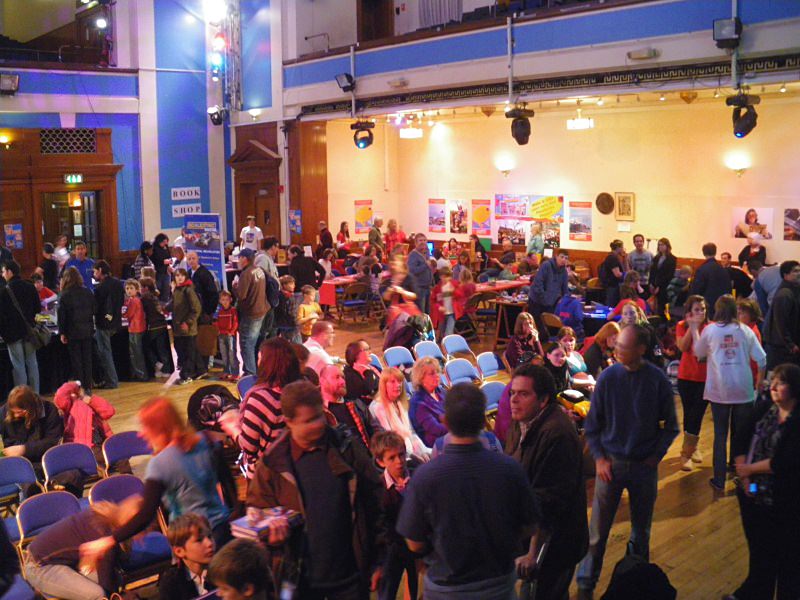
A general view of the toy fair
I couldn’t get near the plastic kit building area (by the way, how many of you bought the Airfix Spitfire after seeing the first programme?). Their stand was also selling kits and other branded items, including an attractive range of coasters with images from the classic range. I missed out on the Q & A session with James May which was earlier in the day.
On the Meccano stand was a table where you could build a small model from the Design range against the clock. The fastest three got a prize of a Meccano set, top prize being one of the Tuning sets and the third one of the new robots. There were also a number of built up remote control cars for children to play with, and these seemed to be very popular. Behind all this was Jim Gamble with a table full of models from his vast collection, mostly in red and green. There was a motor chassis, a set 10 robot man (10.27) who walked across the floor, much to everyone’s delight.
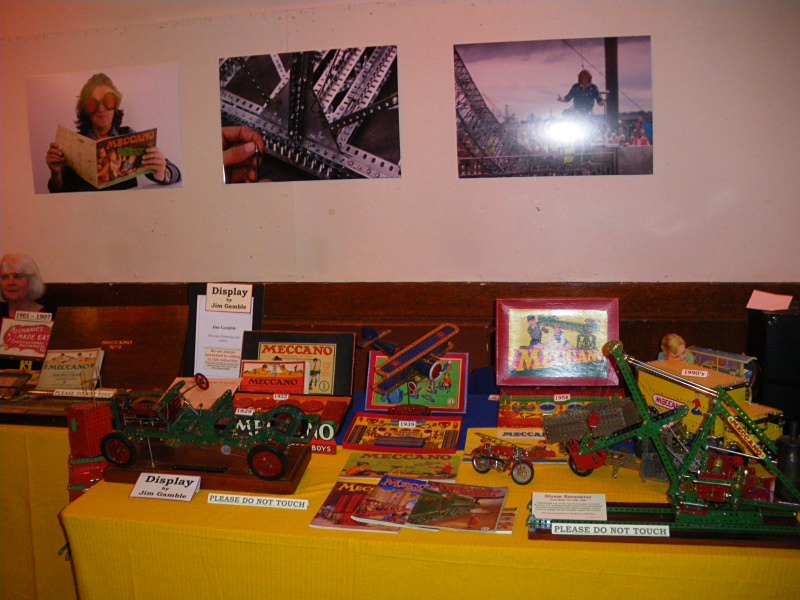
im Gamble’s display
I didn’t have a go at the Meccano building — if I won I’d deprive someone of a set that might open up a whole new hobby to them; if I lost it would just be embarrassing!
The Hornby Trains layout was impressive, with a large four track circuit with sidings and a station. There were several sets of the new 5-car class 395 South Eastern high speed trains running around, as well as some more traditional trains.
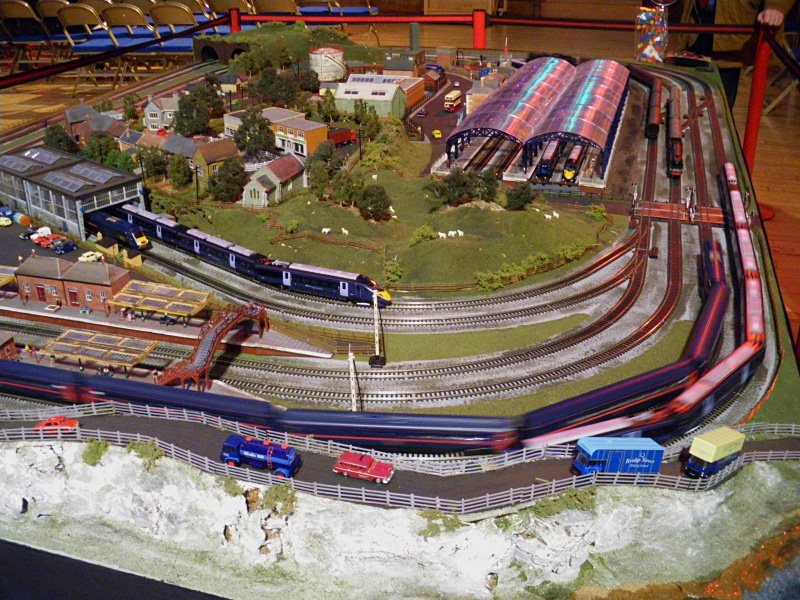
The Hornby railway layout
I had a go on the Scalextric track which uses a digital system similar to that on model railways: you can run several cars on the same track at the same time, each with its own controller. Four cars went around the track at a time. I was useless at this and came last in the heat I was in. The eventual winner was to have raced against James May, but I got the impression that he’d already left by the time they got to find a challenger.
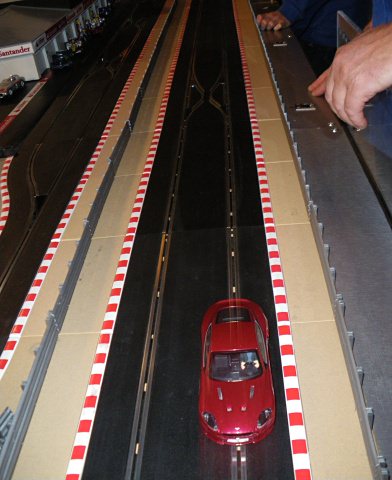
The Scalextric racing track
On the Lego stand was an area where you could build some models, plus various objects from the Lego house including the very lifelike portrait of Mr May.
I had a lengthy chat with Terry Harbutt, the great-grandson of William Harbutt — the inventor of Plasticine. He had a display of historical items from the original firm, including an old packet of the stuff that proudly stated that, amongst its uses, was sealing around windows in case of gas attacks!
It was a very enjoyable afternoon. It was sad to note that all the supposedly British toys (or originally British) are now made overseas with everything from the current Hornby stable (Trains, Airfix and Scalextric) being manufactured in China or India. But, at least they are still being made!
The book is more then just a TV tie-in. Written by James May with Ian Harrison, it is divided into six chapters; one for each programme. In each case there is a two page introduction to the toy. There follows a well researched history of the toy in question. In the Meccano section this runs to sixteen pages and goes into such details as the change of name to Meccano, the various colour schemes, and some of the more popular sets. Amongst the books listed in the bibliography were two books by Bert Love: The Meccano System and the Meccano Constructor’s Guide. The main section in each chapter looks at the problems that had to be overcome in making the idea a reality. If you have some Christmas money to spend, or some socks you didn’t want, take them back and get a refund and buy the book instead!
Written by Frank Paine
For many years, at least as long as I have been interested in our hobby, there has been a debate on the proper pronunciation of the word Meccano among enthusiasts. In fact, there was apparently a prolonged discussion on Spanner concerning this burning question some while ago, with some correspondents quoting dictionaries and all sorts of learned sources.
The definitive answer, however, has been under our noses all the time! In volume 1, issue 2 of the Meccano Magazine for November – December 1916, the Editor’s reply in Our Mail Bag to a correspondent, who presumably asked the relevant question, is as follows:
So, there we have it – debate over. The Editor was probably Frank Hornby himself, or at least all the content of the early Meccano Magazines would have been very carefully scrutinised and vetted by him personally, so I think we can say that we now know for sure!